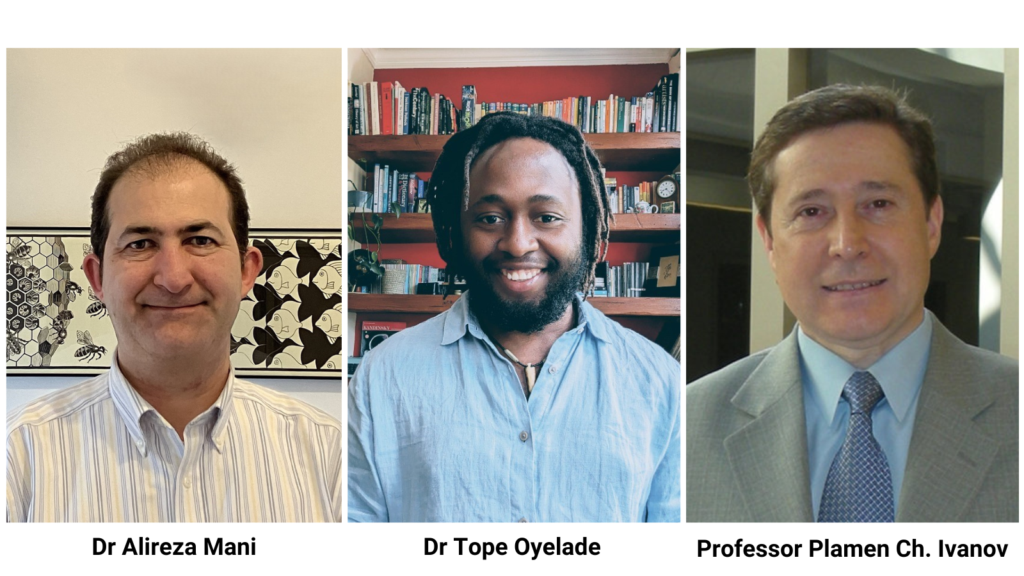
Network Physiology is the new frontier in physiology and medicine. The field was first introduced by Professor Plamen Ch. Ivanov (Boston University, US) explaining how health and disease could be redefined by focusing on the complex coordination and dynamic interactions of diverse physiological systems, networks and organs, instead of working on each in isolation. In this blog, Professor Plamen Ch. Ivanov joins Dr Alireza Mani (University College London, UK) and Dr Tope Oyelade (Keele University, UK and University College London, UK), the speaker and organisers of our upcoming webinar series ‘Network Physiology: Mapping Physiological Networks in Health and Disease’, to tell us more about the new multidisciplinary field.
The human organism is an integrated network, where multi-component physiological systems, each with its own regulatory mechanism, continuously interact to synchronise their dynamics and coordinate their functions. Physiological interactions occur at multiple levels of integration and spatiotemporal scales to generate distinct physiological states, behaviours and conditions at the organism level. Disrupting communications among physiological systems can lead to dysfunction of individual systems or collapse of the entire organism, as observed under clinical conditions such as neurodegenerative disorders, cardiac arrest, sepsis, coma and multiple organ failure.
Yet, despite its importance to basic physiological functions and clinical practice, the nature of interactions between systems and sub-systems, and their collective role as adaptive dynamic network in health and disease remain largely unknown. A new theoretical framework, analytic and computational tools are needed to quantify network interactions among diverse physiological systems and to derive network-based biomarkers of diagnosis and prognosis.
A new multidisciplinary field for cross-communication and integration
Despite the vast progress and achievements in systems biology and integrative physiology in the last decades, we do not know the basic laws of cross-communication, the principles of integration across spatiotemporal scales and the mechanisms through which physiological systems and organs dynamically interact and integrate their functions as a network to generate various states and conditions.
A new multidisciplinary field, Network Physiology, has emerged with the aim to address these fundamental questions. In addition to defining health and disease through structural, dynamical and regulatory changes in individual physiological systems, the new conceptual framework of Network Physiology focuses on the coordination and network interactions among diverse systems and sub-systems as a hallmark of physiological state and function.
Novel concepts and approaches derived from recent advances in control and adaptive networks theory, synchronisation and coupled dynamical systems, information theory, data science, signal processing and biomedical engineering show promise to provide new insights into the complexity of physiological networks structure and function in health and disease, bridging sub-cellular level signalling with inter-cellular interactions and communications among integrated organ systems and sub-systems. These advances form the first building blocks in developing new methodological formalism and theoretical framework necessary to quantify networks of diverse systems characterised by different dynamics and time varying interactions, and to address the problems and challenges in the field of Network Physiology.
Shifting the focus from single systems to the network of physiologic interactions
The innovative holistic perspective offered by Network Physiology changes the current paradigm of defining health and disease by shifting the focus from single systems to the network of physiologic interactions. In recent years, investigations in the field have led to the discovery of new laws of physiological network regulation, shedding light on how physiological states and functions in health and disease emerge from adaptive network interactions among systems.
Since initiation of Network Physiology by Plamen Ch. Ivanov, Boston University, more than one and a half decades ago, coordinated interdisciplinary research efforts in the field have uncovered basic principles of systems integration, hierarchical structure in networks of physiological interactions, global network evolution across states paralleled by re-organisation of distinct network modules, motifs, and communities of physiological systems and sub-systems, and have established unique associations between physiologic network maps and states/functions in health and disease.
The Network Physiology framework has been utilised to advance investigations in various areas of physiology and medicine — from dynamic metabolic and proteomic network processes, pancreatic insulin cellular networks, networks of distinct neuronal populations, and the astrocytes-neuronal-glial multiplex to brain functional networks, cardio-vascular, respiratory, muscles/muscle-fiber networks, and brain-organ networks to comorbidity networks.
Join us for our Network Physiology Webinar Series
To discuss recent advances in the field of Network Physiology, we have organised a series of webinars in collaboration with The Physiological Society. This Webinar Series aims to introduce Network Physiology to the broad community and is structured in four sessions that will focus on: (1) organ systems interactions during basic physiological states (sleep/wake, rest/exercise) in health and neurodegenerative disorders, and applications of data-driven physiological network mapping in clinical practice (Network Physiology: The New Frontier in Physiology and Medicine Overview); (2) Application of network physiology in extreme environment and non-invasive assessment of cardio-respiratory network dynamics under conditions of stress (Network Physiology in Extreme Environments); (3) Physiological networks under clinical conditions such as sleep disordered breathing and sepsis (Network Physiology in Respiratory Diseases and Critical Care); (4) Multisystem involvement in liver disease and liver failure (Network Physiology in Liver Failure).
This Webinar Series is organised in conjunction with the Fourth International Summer Institute on Network Physiology, at Lake Como School for Advanced Studies, Como, Italy.
If you are fascinated by the intricate interactions among physiological systems and their role in health and disease, please join our upcoming webinars on Network Physiology, engage with experts, and be part of the conversation!
Register now for each webinar using the links below:

